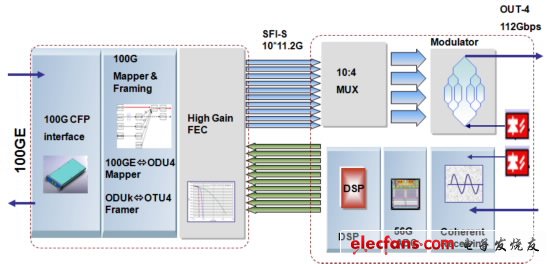100G line solution In the field of 100G line transmission technology, the mainstream solution in the industry is to adopt PDM-QPSK code modulation technology, adopt coherent reception at the receiving end and compensate for dispersion and PMD through digital change and DSP processing. The mechanism of each manufacturer on the modulation side is basically the same. Both of the two key processes of polarization mode division multiplexing and four-phase modulation are used to reduce the high-speed 100G signal transmission code rate, and the code rate is reduced to 28 Gbps by processing. The main difference achieved by each manufacturer is that Receiver AD conversion, DSP algorithm processing and FEC codec are embodied in OSNR tolerance, CD/PMD compensation value and specific transmission specifications. The transmission specification of PDM-QPSK in the line can reach 1200km (15*22dB), line wavelength. The frequency interval is 50 GHz and the transmission capacity can reach 8T. PDM-QPSK modulation and Coherent detection technology have been identified by the OIF International Standardization Organization as the standard transceiver method for future 100Gbps long-distance transmission, and have become a research hotspot in the industry. The other 100G line coding Solutions in the industry also have 2SC-DP-QPSK solution, which is basically the same as the acceptance mechanism of PDM-QPSK. It also adopts coherent reception technology. 100G uses two 56G sub-wavelengths to achieve reverse frequency multiplexing. The frequency interval is 25GHz. The line transmission rate can also reach 8T, which is the same as the spectrum efficiency of PDM-QPSK. Due to the use of 56G four-phase modulation and polarization multiplexing, the code rate is only 14Gbps, which is close to the 10G rate. When mixed with 10G, the XPM effect is larger and the anti-linear ability is relatively weak. With the transmitter end, the device implementation is more complicated, and the implementation cost is relatively high. Another 100G solution is OPFDM-DQPSK, and its receiving end uses non-coherent receiving technology, which is mainly used for compatible hybrid transmission with 10G/40G non-coherent systems of existing networks. Two 56G wavelength inverse multiplexing are used on the line. Implementation, the advantage is that the system design is very similar to the original non-coherent 10G/40G system optical layer parameters, will not bring additional dispersion cost, the line frequency interval is also 50GHz, the system capacity can reach 4T, more positioning Metro network application. 100G network solution Network mixed transmission solution With the coming of the 100G era, how 100G and the existing network are compatible with transmission has become the focus of the industry. It is necessary to consider several major influencing factors, including the system's OSNR tolerance, CD/PMD tolerance and nonlinear effects. There are three main types of mixed transmission scenarios: First, coherent 100G (PDM-QPSK) and non-coherent 10G/40G have mixed systems. As we all know, the 100G solution with coherent receiver can bring many benefits to the network, such as saving DCM module, optical layer planning is simpler, etc. However, when the original system, especially 10G non-coherent hybrid transmission, the original system DCM module pair How much impact a coherent system will have is always a concern. Laboratory tests show that the cost of the non-coherent system for the additional OSNR of the coherent system is not higher than 0.5dB, the impact is small, and the coherent optical power of the coherent 100G can reach 1-2dBm, which is close to the existing 10G system. The OSNR parameter can meet the design requirements of 100G and 10G at the same time, and the compatible mixed transmission can be realized. Second, the hybrid transmission of coherent 100G and coherent 40G systems. For 40G coherent systems, there are two mainstream coding technologies in the industry, one adopts 2-phase modulation PDM-BPSK, the code rate is 21.5Gbps, and the fiber-input power is close to 100G coherence and 10G system, which is the easiest solution for smooth mixed transmission. Another 40G coherent adopts 4-phase modulation PDM-QPSK, the code rate is 11.25Gbps, the anti-linearity is weak, the fiber input power is low, and the 100G coherent compatible hybrid transmission cost is large, and it needs to be carefully designed in the mixed transmission scene. . Third, non-coherent 100G (OPFDM) and incoherent 10G/40G hybrid transmission. The optical layer design parameters of the non-coherent 100G are close to those of the existing 10G/40G system, and the impact cost is small. As long as the OSNR meets the design at the same time, the hybrid transmission can be realized. Here you can find the related products in Optical Cable assembly,, we are professional manufacturer of optical cable assembly, fiber optic cable assemblies, fiber cable assembly, fiber optic cable assembly. We focused on international export product development, production and sales. We have improved quality control processes of optical cable assembly, to ensure each export qualified product. Optical Cable Assembly,Fiber Optic Cable Assemblies,Fiber Cable Assembly,Fiber Optic Assembly Huizhou Fibercan Industrial Co.Ltd , https://www.fibercannetworks.com
If you want to know more about the products in optical cable assembly, please click the product details to view parameters, models, pictures, prices and other information about optical cable assembly, fiber optic cable assemblies, fiber cable assembly, fiber optic cable assembly.
Whatever you are a group or individual, we will do our best to provide you with accurate and comprehensive message about optical cable assembly!